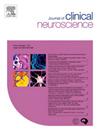荧光素钠与术中超声检查荧光素钠在胶质母细胞瘤切除术中的疗效比较
IF 1.8
4区 医学
Q3 CLINICAL NEUROLOGY
引用次数: 0
摘要
本研究探讨术中超声(IOUS)联合荧光素钠(SF)评估idh1野生型胶质母细胞瘤肿瘤切除完整性的有效性。通过比较SF与IOUS与术后磁共振成像(MRI)检测残留肿瘤,我们旨在评估其在提高手术精度和神经外科预后方面的潜力。方法选取2015-2024年间行SF或SF联合IOUS切除的成年幕上idh野生型4级胶质母细胞瘤患者。结果97例患者符合纳入标准(SF组49例,合并欠条组48例)。SF合并欠条组的GTR(83.3%)高于SF组(67.3%),但差异无统计学意义(p = 0.112)。因肿瘤侵袭重要解剖部位而行次全切除的术后MRI残余肿瘤,SF组中6/49(12.2%)患者阳性(通告:0.447,p = 0.001), SF合并IOUS组中4/48(8.3%)患者阳性(通告:0.625,p <;0.001)。计算SF组和SF组与术后MRI结果比较术中残留肿瘤预测的敏感性、特异性、阴性预测值、阳性预测值。SF组与SF合并欠条组的比较显示,SF组的估计平均生存时间有统计学意义,SF组为14个月(标准误差:1.236),SF合并欠条组为24个月(标准误差:4.103)(p <;0.001)。SF组11/49(22.4%)患者和SF合并欠条组10/48(20.8%)患者术后出现新发神经功能缺损(p >;0.05)。在SF合并欠条组中,26/48(54.2%)、14/48(29.2%)和8/48(16.7%)患者的Karnofsky Performance Status评分分别为90 - 100,70 - 80和<;分别为70例(p = 0.525), 1个月时病情恶化12例,稳定24例,好转12例。结论ssf联合白条为GTR的成功实施和手术效果的改善提供了可靠的影像学手段。然而,需要进一步的研究来克服其局限性,更好地定义其术中作用。本文章由计算机程序翻译,如有差异,请以英文原文为准。
Comparison of sodium fluorescein and sodium fluorescein with intraoperative ultrasonography Efficacy in glioblastoma resection
Background
This study investigated the effectiveness of intraoperative ultrasonography (IOUS) combined with sodium fluorescein (SF) in evaluating tumor resection completeness in patients with glioblastoma IDH1-wildtype. By comparing SF with IOUS with postoperative magnetic resonance imaging (MRI) for detecting residual tumors, we aimed to evaluate its potential in improving surgical precision and neurosurgical outcomes.
Methods
Adult patients with supratentorial IDH-wildtype grade 4 glioblastoma who underwent resection using SF or SF with IOUS during 2015–2024 were included.
Results
A total of 97 patients met the inclusion criteria (49 SF group and 48 SF with IOUS group). The gross total resection (GTR) rate was higher in the SF with IOUS group (83.3 %) than in the SF group (67.3 %), although the difference was not statistically significant (p = 0.112). For residual tumors according to postoperative MRI findings as a result of subtotal resection due to tumor invasion of eloquent anatomical locations, 6/49 (12.2 %) patients in the SF group showed a positive result (ϰ: 0.447, p = 0.001), and 4/48 (8.3 %) patients in the SF with IOUS group showed a positive result (ϰ: 0.625, p < 0.001). The sensitivity, specificity, negative predictive value, and positive predictive value for predicting residual tumors peroperatively compared with postoperative MRI results were calculated for the SF and SF with IOUS groups. Comparison between the SF and SF with IOUS groups revealed a statistically significant difference in the estimated mean survival time, with 14 months (standard error: 1.236) for the SF group and 24 months (standard error: 4.103) for the SF with IOUS group (p < 0.001). In total, 11/49 (22.4 %) patients in the SF group, and 10/48 (20.8 %) patients in the SF with IOUS group experienced newly developed neurological deficits postoperatively (p > 0.05). In the SF with IOUS group, 26/48 (54.2 %) patients, 14/48 (29.2 %) patients, and 8/48 (16.7 %) patients had Karnofsky Performance Status scores of 90–100, 70–80, and < 70, respectively (p = 0.525), and 12 patients experienced deterioration, 24 patients were stable, and 12 patients had improved at 1 month.
Conclusions
SF with IOUS provides a reliable imaging modality for achieving successful GTR and improving surgical outcomes. Nevertheless, further research is necessary to overcome its limitations and better define its intraoperative role.
求助全文
通过发布文献求助,成功后即可免费获取论文全文。
去求助
来源期刊

Journal of Clinical Neuroscience
医学-临床神经学
CiteScore
4.50
自引率
0.00%
发文量
402
审稿时长
40 days
期刊介绍:
This International journal, Journal of Clinical Neuroscience, publishes articles on clinical neurosurgery and neurology and the related neurosciences such as neuro-pathology, neuro-radiology, neuro-ophthalmology and neuro-physiology.
The journal has a broad International perspective, and emphasises the advances occurring in Asia, the Pacific Rim region, Europe and North America. The Journal acts as a focus for publication of major clinical and laboratory research, as well as publishing solicited manuscripts on specific subjects from experts, case reports and other information of interest to clinicians working in the clinical neurosciences.
 求助内容:
求助内容: 应助结果提醒方式:
应助结果提醒方式:


